I’m going to say something that might be controversial: as a standalone technology, transcription is dead. If your AI tool’s biggest selling point is turning speech into text, your workflow is already a generation behind. The future isn’t transcription; it’s Conversation Intelligence.
Transcription and Conversation Intelligence might sound similar, but the gap between them is like the difference between an abacus and a supercomputer. Want to understand why? You’re in the right place. Today you’re going to learn why transcription is just the starting point and how the true future—Conversation Intelligence—will completely revolutionize the way you work. Let’s look at a detailed comparison.
Core Philosophy: Recording the Past vs. Empowering the Present
First up, let’s understand the fundamental difference in purpose. This is the most important distinction and it informs every feature we’ll discuss.
- Transcription’s Goal: To Create a Faithful Record of the Past. The primary objective of a traditional transcription tool is to be a perfect, passive observer. It’s designed to answer the question, “What was said?” It creates a searchable, accurate archive of a conversation that has already happened. In other words, its entire focus is on auditing history. It’s a tool for looking backward.
- Conversation Intelligence’s Goal: To Empower Your Decisions in the Present. On the other hand, a Conversation Intelligence (CI) platform has a much more ambitious goal. Its purpose is to actively help you during the conversation and immediately after. It uses the past (your conversation history) and the present (the live discussion) to help you make better decisions now. Its focus is on empowering the present moment and shaping the future. It’s a tool for moving forward.
This philosophical difference is the key to understanding why one is an obsolete concept and the other is the future.
The Feature Matrix Showdown
Here’s the deal: a feature-by-feature comparison makes the gap between these two technologies crystal clear. Let’s see how a basic transcription tool stacks up against a true Conversation Intelligence platform like Proactor AI.
| Feature | Basic Transcription Tool | Conversation Intelligence (CI) Tool (e.g., Proactor AI) |
|---|---|---|
| Real-Time Transcription | ✅ | ✅ |
| Keyword Highlighting | ✅ | ✅ |
| Real-Time Insights & Advice | ❌ | ✅ |
| Cross-Meeting Memory | ❌ | ✅ |
| Intelligent Task Extraction | ⚠️ (Basic) | ✅ (Contextual) |
| Proactive Fact-Checking | ❌ | ✅ |
| Intelligent Knowledge Base Generation | ❌ | ✅ |
As you can see, the shared features are just table stakes. The real, game-changing value lies in the features that transcription tools simply don’t have.
A Deep Dive into the Key Differences
That table gives us a great overview, but to truly grasp the difference, we need to go deeper. Let’s break down the three biggest differentiators that separate a simple recorder from an intelligent partner.
Difference #1: Memory – The Great Divide
Here’s the kicker: traditional transcription tools have amnesia. Every meeting is a blank slate. The tool that recorded your Q1 strategy session has absolutely no memory of it when you join your Q2 planning call. This creates massive information silos.
A basic transcription tool gives you a folder full of disconnected text files. It’s your job to manually connect the dots between them. It’s a GRIND.
A Conversation Intelligence platform, however, is built on a foundation of memory. Here’s how it works in a tool like Proactor AI:
- It builds a Global Memory: Every conversation isn’t just saved; it’s indexed and added to a central “second brain.” The AI learns the key people, projects, and concepts that are important to you.
- It creates a Knowledge Graph: Over time, it doesn’t just store data; it understands relationships. It knows that “Project Titan” mentioned in January is the same “Project Titan” being debated in March. It connects the dots for you.
This is a whole different ball game. A tool with memory can answer questions like, “What were the main objections raised the last time we discussed this pricing model?” A tool without memory can only answer, “Here is the transcript from that meeting. Good luck finding it.”
Difference #2: Proactivity – The Shift from Servant to Partner
The second major difference is the shift from a passive to a proactive stance.
A transcription tool is a servant. It waits for your commands. It records when you tell it to and stops when you tell it to. It does its job perfectly, but it will never offer an unsolicited opinion or a helpful suggestion. It’s a tool, and nothing more.
A Conversation Intelligence platform is a partner. It actively participates in the workflow. It anticipates your needs. For example, in Proactor AI, this proactivity comes to life through the Insight Stream:
- Proactive Fact-Checking: If a team member says, “I think our user growth was up 15% last quarter,” a CI tool can cross-reference its memory and gently provide a correction in a private feed: “According to the Q1 review, user growth was 12%.” This prevents decisions from being made based on faulty data.
- Proactive Suggestions: When it detects a problem being discussed, it can offer solutions. If a team is brainstorming marketing ideas, the AI might add, “Based on recent industry trends, video-based content on LinkedIn has shown a higher engagement rate for B2B tech companies.”
This is the difference between an employee who only does what’s in their job description and one who actively looks for ways to help the team win.
Difference #3: The Output – From a Text File to a Knowledge Asset
Finally, let’s consider what you’re left with after the meeting is over.
With a traditional transcription tool, your output is a data dump. You get a long, flat text file or a basic note. It’s a static record of a past event. While searchable, the burden is entirely on you to extract value from it. You have to read it, synthesize it, organize it, and decide what to do with it.
With a Conversation Intelligence platform, your output is a dynamic knowledge asset. Proactor AI, for instance, doesn’t give you a transcript; it gives you an Intelligent Wiki. This includes:
- A high-level summary.
- A list of key takeaways.
- A structured list of action items.
- A full history of the AI Advice provided.
- The complete, time-stamped transcript.
This isn’t just a file; it’s a pre-organized, pre-synthesized package of knowledge. It transforms the post-meeting workflow from a multi-hour task of organization into a simple act of distribution.
What This Means for Your Team
So, what does this all add up to? The choice between these two technologies creates two very different futures for your team’s knowledge management.
- When You Use Transcription Tools… You get an ever-expanding information graveyard. Every meeting adds another isolated file to a massive, disconnected archive. The knowledge exists, but it’s buried. Over time, this becomes a source of drag and inefficiency, as team members spend more and more time trying to find information they know they have somewhere.
- When You Use Conversation Intelligence Tools… You get a compounding “second brain” for your team. Every meeting makes the AI smarter and more useful. The knowledge from one conversation actively informs the next, creating a virtuous cycle of intelligence. Your team’s collective knowledge becomes an accessible, ever-growing asset, not a burdensome archive.
The Verdict: Stop Paying for Dead Technology
The bottom line is this: transcription is now just a feature, not a product. It’s the raw material. The real value is in the “intelligence” layer that’s built on top of it.
In fact, continuing to invest in a tool whose only job is transcription is like investing in a company that only manufactures CD players in the age of streaming. You’re investing in a technology that is destined to be obsolete.
It’s time to shift your investment—and your thinking—to the future. It’s time to embrace Conversation Intelligence.






